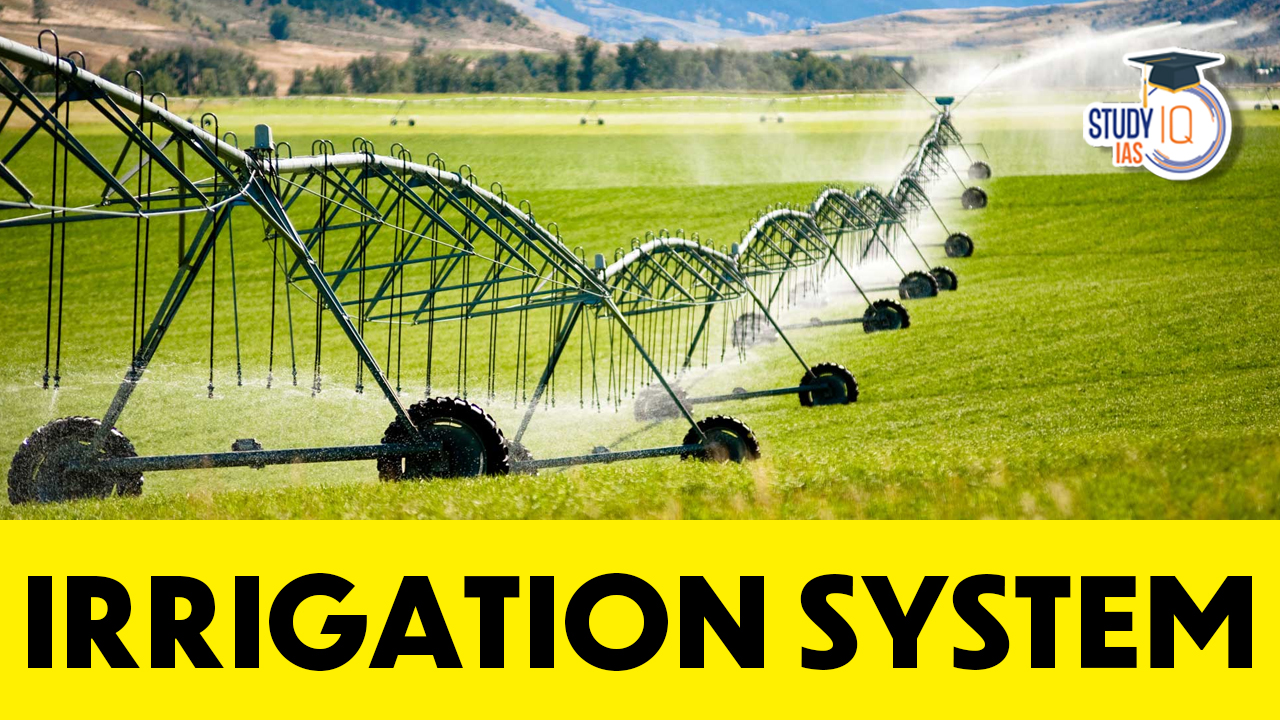Table of Contents
Irrigation System
In agriculture, having a good irrigation system is very important. With water shortages and unpredictable rainfall farmers need reliable irrigation to grow their crops. A proper water supply helps plants grow well and produce good yields. This article will explore different aspects of irrigation systems and their benefits for farming. Different regions in India have unique landscapes and climates, so various irrigation methods have been created to meet their specific needs. These systems provide a steady water supply for crops, helping the agricultural economy and ensuring food security.
Read about: Cropping Patterns
What is Irrigation System?
An irrigation system is a method used to provide water to crops in agricultural fields. Irrigation helps provide water to plants directly at their roots, especially when there is not enough rain. It uses pipes, channels, pumps, sprinklers, or drip emitters to spread water efficiently. The main goal is to keep crops well-watered for healthy growth, even in dry areas or during dry seasons. This is important for improving crop health, increasing yields, and supporting sustainable farming.
Read about: Tropical Climate
Types of Irrigation System
Various types of irrigation systems are employed worldwide to meet the diverse needs of different regions and crops. Here is a tabulated description of them.
| Irrigation System | Characteristics | Prominent Areas of Usage |
| Surface Irrigation | Water is distributed over the soil surface and infiltrates the soil through gravity flow. |
|
| Sprinkler Irrigation | Water is sprayed through sprinklers, creating a fine mist that falls onto the crops. |
|
| Drip Irrigation | Water is applied directly to the plant root zone in small, controlled amounts through drip emitters. |
|
| Center Pivot Irrigation | Water is distributed from a central pivot point, with sprinklers rotating in a circular pattern. |
|
| Subsurface Irrigation | Water is delivered directly to the root zone through buried pipes or tubes. |
|
Read about: Heat Zones of Earth
Irrigation System in India
In India, agriculture is very important for the economy, so using water resources wisely is Important. Different regions have different climates and water supplies, leading to various irrigation systems for crops. Below is a table that describes the different types.
| Irrigation System | Features | Advantages | Disadvantages | Areas of Practice |
| Canal Irrigation | Water supplied through canals from rivers or reservoirs |
|
|
Gangetic plains, Punjab, Haryana, Uttar Pradesh, Rajasthan |
| Tank Irrigation | Water stored in tanks or reservoirs during the monsoon |
|
|
Tamil Nadu, Karnataka, Andhra Pradesh, Deccan Plateau |
| Well Irrigation | Water extracted from underground wells using pumps |
|
|
Punjab, Haryana, Uttar Pradesh, Maharashtra, Gujarat |
| Tube Well Irrigation | Water extracted from deeper underground sources using tube wells |
|
|
Punjab, Haryana, Uttar Pradesh, Gujarat, Rajasthan, Bihar |
| River Lift Irrigation | Water lifted from a river and distributed through canals for irrigation |
|
|
Punjab, Haryana (from Sutlej River), Tamil Nadu (from Cauvery River), Andhra Pradesh (from Krishna River), Telangana (from Godavari River) |
| Drip Irrigation | Water delivered directly to the plant root zone through small emitters |
|
|
Maharashtra, Gujarat, Karnataka, Tamil Nadu |
Read about: World Environment Day
Irrigation System UPSC
The topic of irrigation systems holds significant importance in the UPSC examination as it aligns with key areas of the UPSC Syllabus, such as Geography, Economy, and Agriculture. Understanding irrigation systems is crucial for comprehending the agricultural landscape, water resource management, and socio-economic aspects of various regions. It is essential for UPSC aspirants to have a comprehensive knowledge of irrigation systems as it aids in formulating effective policies, addressing water-related challenges, and promoting sustainable development. UPSC Online Coaching and UPSC Mock Test can provide candidates with in-depth insights and practical application of concepts related to irrigation systems, enabling them to excel in the examination.
Read about: Types of Soil in India


 Purchasing Power Parity Index, How to Ca...
Purchasing Power Parity Index, How to Ca...
 Unemployment Rate in India, Current Rate...
Unemployment Rate in India, Current Rate...
 RBI Monetary Policy Committee: Repo Rate...
RBI Monetary Policy Committee: Repo Rate...

























